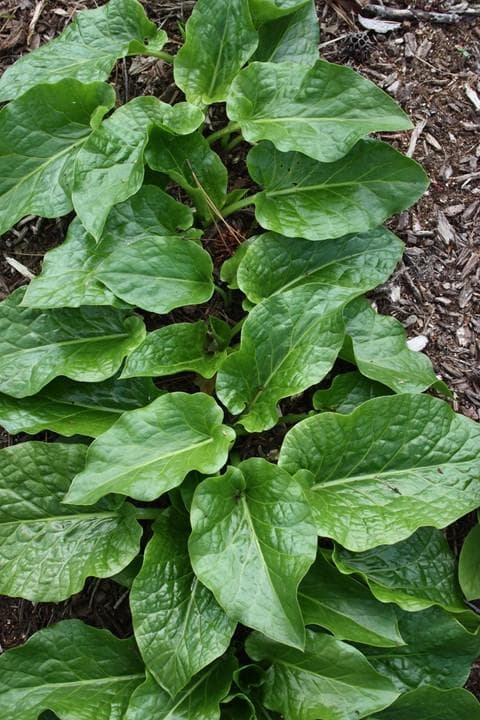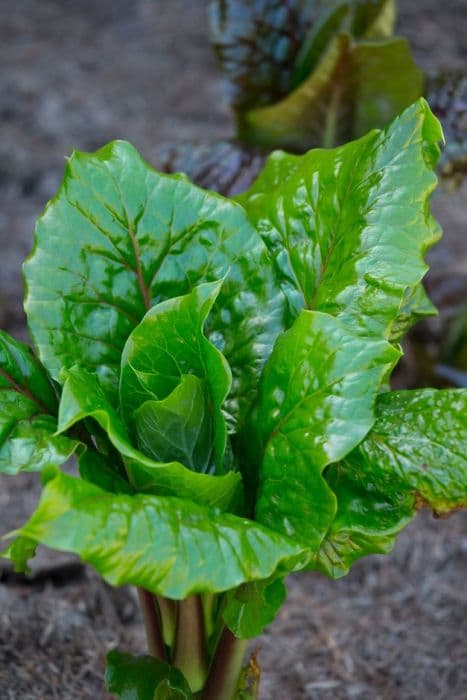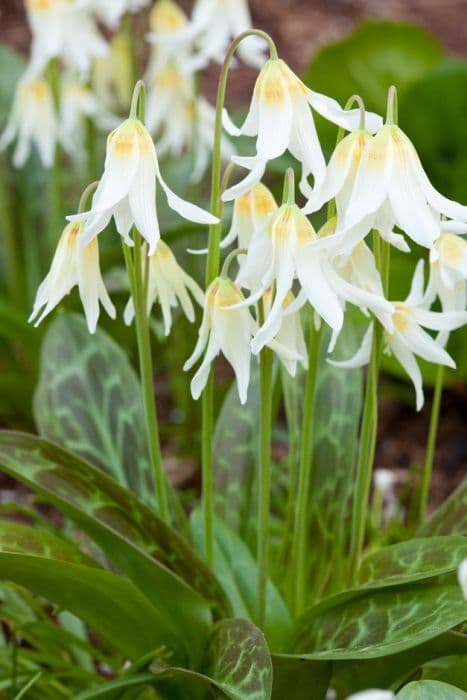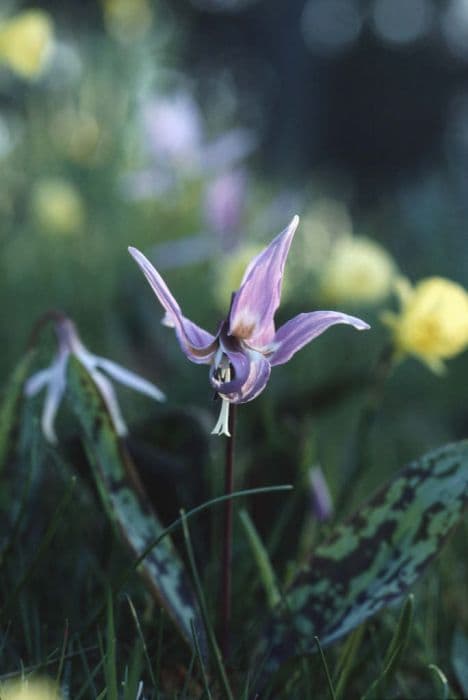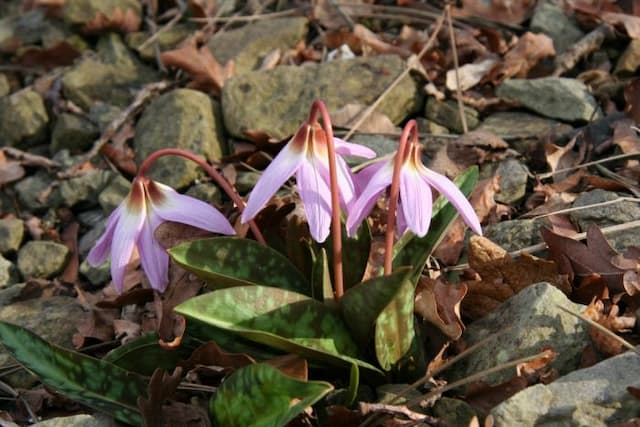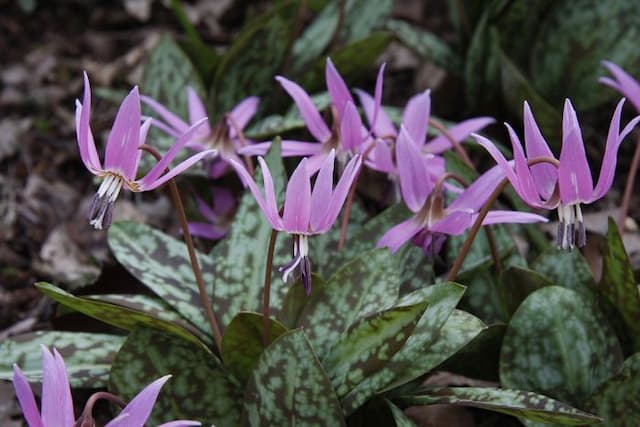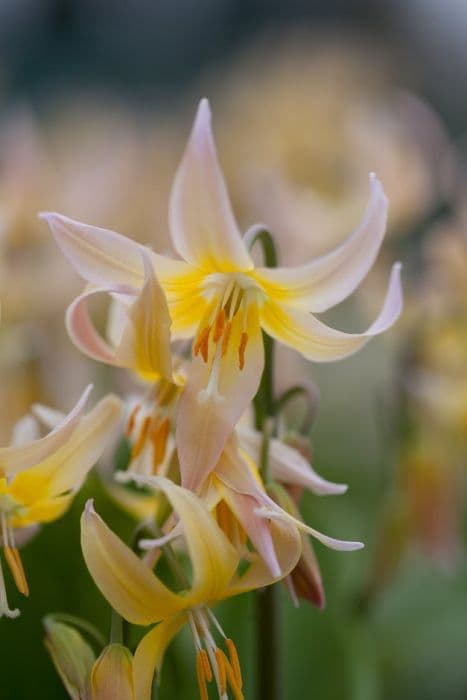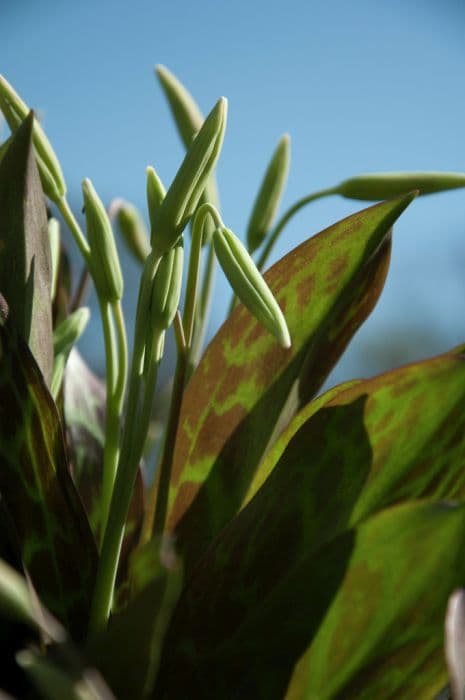Tulip 'Blue Ribbon' Tulipa 'Blue Ribbon' (3)

ABOUT
'Blue Ribbon' flowers in late spring, reaching a height of around 35cm. Its goblet-shaped flowers are a lilac-blue with an internal, basal blotch of green
About this plant
 Names
NamesFamily
Liliaceae
Synonyms
Tulip, Blue Ribbon Tulip
Common names
Tulipa 'Blue Ribbon'
 Characteristics
CharacteristicsLife cycle
Perennials
Foliage type
Deciduous
Color of leaves
Green
Flower color
Blue
Height
1-2 feet (30-60 cm)
Spread
6 inches (15 cm)
Plant type
Bulb
Hardiness zones
3
Native area
Central Asia
Benefits
 General Benefits
General Benefits- Aesthetic Appeal: The Tulipa 'Blue Ribbon', commonly known as the tulip, adds vibrant color and beauty to gardens and landscapes with its striking blue-hued flowers.
- Seasonal Interest: Tulips are known for signaling the arrival of spring, providing early seasonal interest after a long winter.
- Ease of Growing: Tulips are relatively easy to grow and can thrive in a variety of soil conditions with adequate drainage and plenty of sunlight.
- Versatility in Landscaping: Tulips can be planted in beds, borders, and containers, offering flexibility in garden design and space utilization.
- Cut Flower Use: Tulips are excellent for cut flower arrangements, allowing the enjoyment of their beauty indoors.
- Pollinator Attraction: While tulips are not the top choice for pollinators, they can still attract bees to the garden when they are in bloom.
- Symbolism and Cultural Significance: Tulips carry symbolic meanings, such as love and happiness, and are celebrated in events like tulip festivals around the world.
 Medical Properties
Medical PropertiesThis plant is not used for medical purposes.
 Air-purifying Qualities
Air-purifying QualitiesThis plant is not specifically known for air purifying qualities.
 Other Uses
Other Uses- Cut Flower Arrangements: The Tulip 'Blue Ribbon' can be used in bouquets and floral displays for its unique color and elegant shape.
- Photography: Due to its distinctive appearance, this tulip variety is often used as a subject in professional and amateur photography to create stunning imagery.
- Educational Tool: Horticulture students and plant enthusiasts may study the Tulip 'Blue Ribbon' to learn about hybridization and cultivation techniques.
- Natural Dyes: The petals of the tulip may be used to extract natural dyes for coloring fabrics or handicrafts.
- Wedding Decor: Its rare color makes the Tulip 'Blue Ribbon' a sought-after option for unique and themed wedding decoration.
- Artistic Inspiration: Artists may use the striking appearance of the tulip as inspiration for paintings, drawings, and other forms of art.
- Drying and Pressing: The flowers can be dried or pressed for scrapbooking, card making, or other crafting activities.
- Garden Design: This variety is often used in garden design, providing a pop of color and helping to create a focal point.
- Culinary Presentation: While not for consumption, the petals can adorn dishes for an elegant presentation in high-end culinary settings.
- Eco-friendly Confetti: Dried petals of Tulip 'Blue Ribbon' can be used as biodegradable confetti for celebrations and events.
Interesting Facts
 Feng Shui
Feng ShuiThe Tulip is not used in Feng Shui practice.
 Zodiac Sign Compitability
Zodiac Sign CompitabilityThe Tulip is not used in astrology practice.
 Plant Symbolism
Plant Symbolism- Renewal and Rebirth: The tulip, in general, symbolizes the beginning of spring and the cycle of life starting anew.
- Perfect Love: Tulips, often associated with love, represent an ideal and deep connection between people.
- Royalty: The 'Blue Ribbon' variety, with its regal hues, can signify majesty and an air of nobility.
 Water
WaterTulips, including the 'Blue Ribbon' variety, should be watered thoroughly when planted and throughout the growing season if there isn't sufficient rain, providing moisture to the roots without leaving the soil waterlogged. During the active growing phase, especially if there is less than 1 inch of rainfall a week, provide additional water to keep the soil moist but not soggy, which could be around 1 gallon per square foot every week. After blooming, gradually reduce watering as the foliage begins to die back, allowing the soil to dry out somewhat as the plant enters dormancy.
 Light
LightThe 'Blue Ribbon' Tulip thrives best in full sun conditions, receiving at least 6 to 8 hours of direct sunlight daily. It's crucial to plant them in a spot that is not shaded by larger plants or structures to ensure they receive adequate light during the growing season. However, they can also tolerate light shade, especially in the hotter parts of the day or in warmer climates.
 Temperature
TemperatureTulips, including the 'Blue Ribbon' variety, prefer cooler temperatures and are hardy in a range of climates. They can survive winter temperatures as low as 20 degrees Fahrenheit and are best planted in the fall when the soil temperature drops below 60 degrees Fahrenheit. The ideal temperature range for tulips when they are actively growing in spring is between 50 and 70 degrees Fahrenheit.
 Pruning
PruningPruning or deadheading 'Blue Ribbon' Tulips involves removing spent blooms after flowering to prevent the plant from expending energy on seed production, which can be done annually once the petals begin to fall. The foliage should not be cut back until it has yellowed and died down naturally, providing the bulbs with nutrients for the next season. The best time for pruning or deadheading is late spring to early summer, after the flowers have faded.
 Cleaning
CleaningAs needed
 Soil
SoilTulips require well-drained soil mixed with compost or well-rotted manure. A pH between 6.0 and 7.0 is ideal for the 'Blue Ribbon' tulip. For optimal growth, incorporate sand and grit for improved drainage and plant bulbs 8 inches deep.
 Repotting
RepottingTulip bulbs, including the 'Blue Ribbon' tulip, don't need to be repotted annually. Repotting is done after the leaves die back in the summer; you lift the bulbs, store them, and replant in the fall.
 Humidity & Misting
Humidity & MistingTulips, such as the 'Blue Ribbon' tulip, thrive in moderate humidity conditions. They are adaptable but prefer drier air when dormant and average humidity when in active growth.
 Suitable locations
Suitable locationsIndoor
Ensure bright light, cool temps; plant in well-draining soil.
Outdoor
Plant bulbs in autumn, full sun to partial shade, well-draining soil.
Hardiness zone
3-8 USDA
 Life cycle
Life cycleTulipa 'Blue Ribbon', commonly known as tulip, begins its life cycle as a bulb, which lies dormant underground during winter. In early spring, the bulb sprouts and the plant's stem, leaves, and flower bud emerge, taking advantage of the cool temperatures. As the temperature warms, the tulip blooms, displaying its distinct blue-ribbon-colored petals. After flowering, the petals fall off, and the plant focuses on replenishing its bulb through photosynthesis conducted by the leaves. Once the foliage dies back in late spring or early summer, the bulb enters dormancy again, storing energy for the next growing season. Each year, the cycle repeats with the bulb potentially producing offset bulbs as well, allowing the tulip to propagate and increase in number.
 Propogation
PropogationPropogation time
Spring to Summer
The most popular method of propagating the Tulip 'Blue Ribbon' is through its bulbs. Propagation typically takes place in the fall, which is the ideal time for planting tulip bulbs. Gardeners should select healthy, disease-free bulbs and plant them about 6 to 8 inches (15 to 20 centimeters) deep in well-drained soil with the pointy end up. It's important to space the bulbs about 4 to 6 inches (10 to 15 centimeters) apart to ensure they have enough room to grow. After planting, water the bulbs thoroughly to encourage root growth before the ground freezes. Come spring, the planted bulbs will sprout and eventually bloom, creating a beautiful display of 'Blue Ribbon' tulips.
